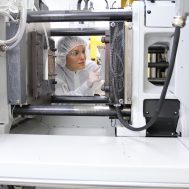Who Works in Injection Molding?
Injection molding is utilized for a variety of applications, from producing very small parts to entire body panels for automobiles. Jobs like machine operator, fabricator, molding line assistant, technician, and molding line operator all fall under the umbrella of injection molding. These jobs are generally shared by the workers who set up and calibrate injection molding machines and those who operate these machines.
Why Rubber Injection Molding?
Rubber injection molding produces parts more quickly than compression or transfer molding processes. The secondary need for preformed molds is eliminated. Rubber injection molding also enables the creation of custom shapes with little flash or rubber waste.
Understanding the Process
Injection molding is the process of filling different sized and shaped molds with heated materials like plastic or rubber to make components or finished products for a wide variety of uses, from airplane parts to toys.
During the rubber injection molding process, uncured rubber is extracted into the machine using a screw feeder system. The screw feeder takes in the exact amount of material needed to create the correct number of parts.
Rubber is fed from a hopper into a heated barrel, and the material is slowly pushed by a screw-like plunger into a heated chamber. Material is then preheated to a state that allows the material to flow through a gate and runner system to evenly fill the cavities. The mold remains at a set temperature so it can solidify once it is filled. When the material has reached a cured state, the mold will open and the parts can be removed manually or using a brush system.
What Do Injection Molding Machine Operators Do?
After a setter has prepared the injection machine, an injection molder machine operator controls the machines that are used to mold the materials. In this job, responsibilities include adding the material into the machine, adjusting the speed of the machine, and monitoring the process to ensure the operations are meeting specifications. Duties also include making periodic inspections of the equipment.
How to Get a Job in Injection Molding
You need at least a high school diploma or G.E.D. to get a job as an injection molder. However, you can improve your job opportunities by taking some postsecondary courses or completing a certificate program in metal or plastic machine operating at a vocational school or community college.
Most entry-level positions provide significant on-the-job training, but if you are looking for a job in which you use advanced computer-operated machines, you need advanced skills and qualifications.
To learn more about injection molding, contact us here.
